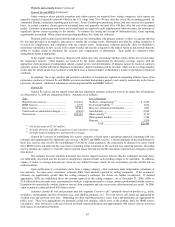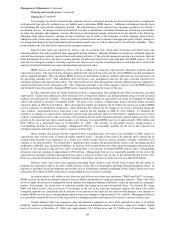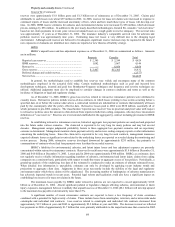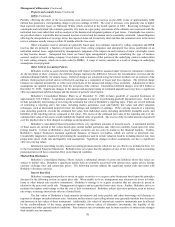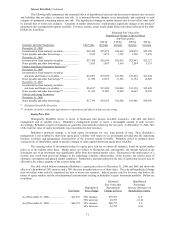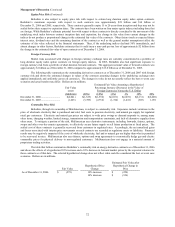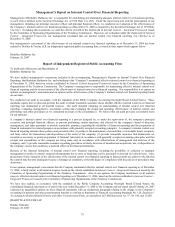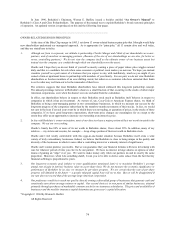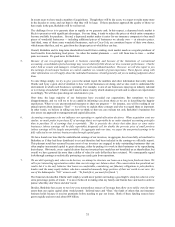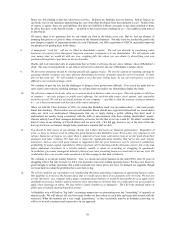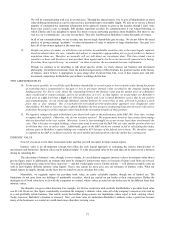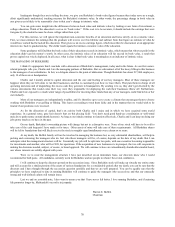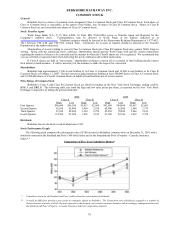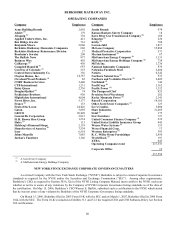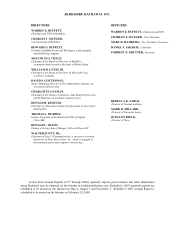Berkshire Hathaway 2006 Annual Report Download - page 78
Download and view the complete annual report
Please find page 78 of the 2006 Berkshire Hathaway annual report below. You can navigate through the pages in the report by either clicking on the pages listed below, or by using the keyword search tool below to find specific information within the annual report. We will be communicating with you in several ways. Through the annual report, I try to give all shareholders as much
value-defining information as can be conveyed in a document kept to reasonable length. We also try to convey a liberal
quantity of condensed but important information in the quarterly reports we post on the internet, though I don’ t write
those (one recital a year is enough). Still another important occasion for communication is our Annual Meeting, at
which Charlie and I are delighted to spend five hours or more answering questions about Berkshire. But there is one
way we can’t communicate: on a one-on-one basis. That isn’ t feasible given Berkshire’ s many thousands of owners.
In all of our communications, we try to make sure that no single shareholder gets an edge: We do not follow the usual
practice of giving earnings “guidance” or other information of value to analysts or large shareholders. Our goal is to
have all of our owners updated at the same time.
13. Despite our policy of candor, we will discuss our activities in marketable securities only to the extent legally required.
Good investment ideas are rare, valuable and subject to competitive appropriation just as good product or business
acquisition ideas are. Therefore we normally will not talk about our investment ideas. This ban extends even to
securities we have sold (because we may purchase them again) and to stocks we are incorrectly rumored to be buying.
If we deny those reports but say “no comment” on other occasions, the no-comments become confirmation.
Though we continue to be unwilling to talk about specific stocks, we freely discuss our business and investment
philosophy. I benefitted enormously from the intellectual generosity of Ben Graham, the greatest teacher in the history
of finance, and I believe it appropriate to pass along what I learned from him, even if that creates new and able
investment competitors for Berkshire just as Ben’ s teachings did for him.
TWO ADDED PRINCIPLES
14. To the extent possible, we would like each Berkshire shareholder to record a gain or loss in market value during his period
of ownership that is proportional to the gain or loss in per-share intrinsic value recorded by the company during that
holding period. For this to come about, the relationship between the intrinsic value and the market price of a Berkshire
share would need to remain constant, and by our preferences at 1-to-1. As that implies, we would rather see Berkshire’s
stock price at a fair level than a high level. Obviously, Charlie and I can’t control Berkshire’s price. But by our policies
and communications, we can encourage informed, rational behavior by owners that, in turn, will tend to produce a stock
price that is also rational. Our it’s-as-bad-to-be-overvalued-as-to-be-undervalued approach may disappoint some
shareholders. We believe, however, that it affords Berkshire the best prospect of attracting long-term investors who seek to
profit from the progress of the company rather than from the investment mistakes of their partners.
15. We regularly compare the gain in Berkshire’s per-share book value to the performance of the S&P 500. Over time, we hope
to outpace this yardstick. Otherwise, why do our investors need us? The measurement, however, has certain shortcomings
that are described in the next section. Moreover, it now is less meaningful on a year-to-year basis than was formerly the
case. That is because our equity holdings, whose value tends to move with the S&P 500, are a far smaller portion of our net
worth than they were in earlier years. Additionally, gains in the S&P stocks are counted in full in calculating that index,
whereas gains in Berkshire’s equity holdings are counted at 65% because of the federal tax we incur. We, therefore, expect
to outperform the S&P in lackluster years for the stock market and underperform when the market has a strong year.
INTRINSIC VALUE
Now let’ s focus on a term that I mentioned earlier and that you will encounter in future annual reports.
Intrinsic value is an all-important concept that offers the only logical approach to evaluating the relative attractiveness of
investments and businesses. Intrinsic value can be defined simply: It is the discounted value of the cash that can be taken out of a business
during its remaining life.
The calculation of intrinsic value, though, is not so simple. As our definition suggests, intrinsic value is an estimate rather than a
precise figure, and it is additionally an estimate that must be changed if interest rates move or forecasts of future cash flows are revised.
Two people looking at the same set of facts, moreover — and this would apply even to Charlie and me — will almost inevitably come up
with at least slightly different intrinsic value figures. That is one reason we never give you our estimates of intrinsic value. What our
annual reports do supply, though, are the facts that we ourselves use to calculate this value.
Meanwhile, we regularly report our per-share book value, an easily calculable number, though one of limited use. The
limitations do not arise from our holdings of marketable securities, which are carried on our books at their current prices. Rather the
inadequacies of book value have to do with the companies we control, whose values as stated on our books may be far different from their
intrinsic values.
The disparity can go in either direction. For example, in 1964 we could state with certitude that Berkshire’ s per-share book value
was $19.46. However, that figure considerably overstated the company’ s intrinsic value, since all of the company’ s resources were tied up
in a sub-profitable textile business. Our textile assets had neither going-concern nor liquidation values equal to their carrying values.
Today, however, Berkshire’ s situation is reversed: Now, our book value far understates Berkshire’ s intrinsic value, a point true because
many of the businesses we control are worth much more than their carrying value.
77


